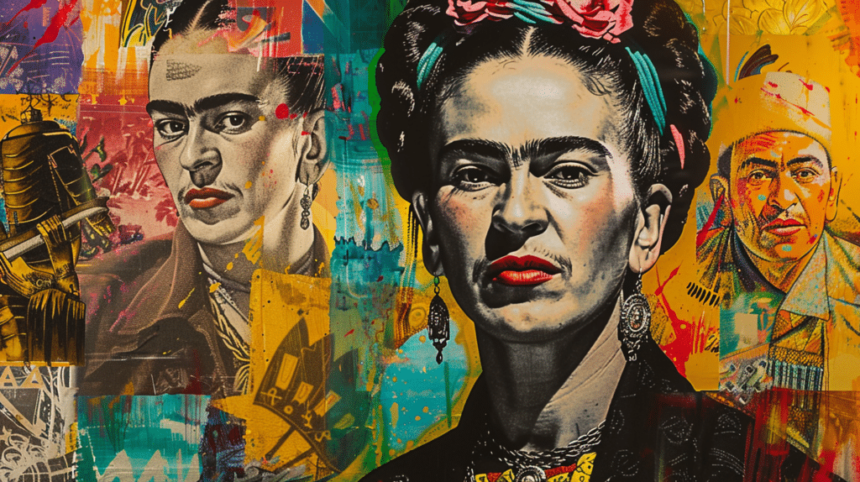The relationship between Mexican painter Frida Kahlo and Diego Rivera is one of the most fascinating and complex love stories in the art world. Both artists left an indelible mark on Mexican art and culture, but their relationship was marked by passion, betrayal, and profound mutual influence. This article delves into the intricacies of their partnership, exploring how their art reflected their tumultuous relationship.
A Meeting of Minds and Hearts
Frida Kahlo and Diego Rivera first met in 1922 when Frida was still a schoolgirl and Rivera was already an established muralist. Their paths crossed again years later when Frida, then a burgeoning artist, sought Rivera’s advice on her work. Impressed by her talent and unique vision, Rivera became her mentor and eventually her lover. They married in 1929, beginning a partnership that would last until Frida’s death in 1954.
Artistic Symbiosis
Rivera’s influence on Kahlo’s work is unmistakable. He encouraged her to embrace Mexican folk art and indigenous traditions, which became central themes in her paintings. Kahlo’s use of vibrant colors, dramatic symbolism, and references to Mexican culture can be attributed to Rivera’s encouragement. However, Kahlo’s art retained a distinct personal touch, characterized by intense self-reflection and exploration of her physical and emotional pain.
On the other hand, Rivera’s work also bears traces of Kahlo’s influence. Known for his large-scale murals depicting social and political themes, Rivera began incorporating more intimate and personal elements into his art after his marriage to Kahlo. The exchange of ideas between the two artists enriched their respective styles, making their works more profound and multifaceted.
Love and Betrayal
Despite their deep connection, Kahlo and Rivera’s marriage was fraught with difficulties. Rivera’s infidelities, including an affair with Kahlo’s sister Cristina, caused immense pain for Kahlo. These betrayals profoundly impacted her art, leading to some of her most famous works, such as “The Two Fridas” and “Self-Portrait with Cropped Hair,” which reflect her anguish and resilience.
Kahlo’s own extramarital affairs, with both men and women, added to the complexity of their relationship. Yet, despite these challenges, the bond between Kahlo and Rivera remained strong. Their love, though tumultuous, was marked by a deep mutual respect and admiration for each other’s artistic talents.
Art as a Reflection of Their Relationship
Kahlo’s art often served as a diary, documenting her physical suffering and emotional turmoil. Her marriage to Rivera is a recurring theme in her work. In “Diego on My Mind” (1943), Kahlo depicts herself with a miniature portrait of Rivera on her forehead, symbolizing his constant presence in her thoughts. Similarly, “The Love Embrace of the Universe, the Earth (Mexico), Myself, Diego, and Señor Xólotl” (1949) portrays Rivera as an integral part of her universe.
Rivera, too, immortalized Kahlo in his murals. In “Dream of a Sunday Afternoon in Alameda Central Park” (1947), he painted a young Frida standing beside him, signifying her importance in his life. His mural “Detroit Industry” (1932-33) includes a portrait of Kahlo, underscoring her influence on his artistic vision.
A Legacy of Love and Art
The relationship between Kahlo and Rivera left a lasting legacy in the art world. Their love story, with all its complexities, continues to captivate and inspire artists and art lovers alike. The Frida Kahlo Museum in La Casa Azul, her former home in Mexico City, and the Diego Rivera and Frida Kahlo Studio Museum in San Ángel celebrate their contributions to Mexican art and culture.
Their works, often displayed together in exhibitions, offer a unique glimpse into their intertwined lives and artistic journeys. Through their art, Kahlo and Rivera communicated their deepest emotions, political beliefs, and cultural heritage, leaving behind a rich tapestry of visual narratives that continue to resonate with audiences worldwide.
Conclusion
The relationship between Mexican painter Frida Kahlo and Diego Rivera was a dynamic and intricate partnership that significantly shaped their art and lives. Despite the challenges and betrayals, their love and mutual artistic influence created some of the most powerful and enduring works in the history of art. Their legacy serves as a testament to the enduring power of love and creativity, inspiring generations to explore the depths of their own artistic expressions.



